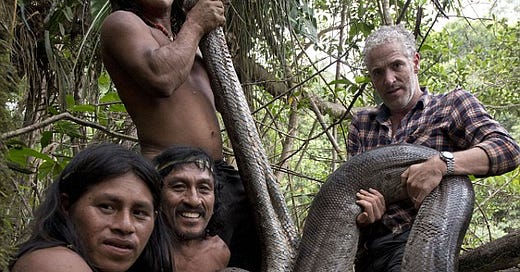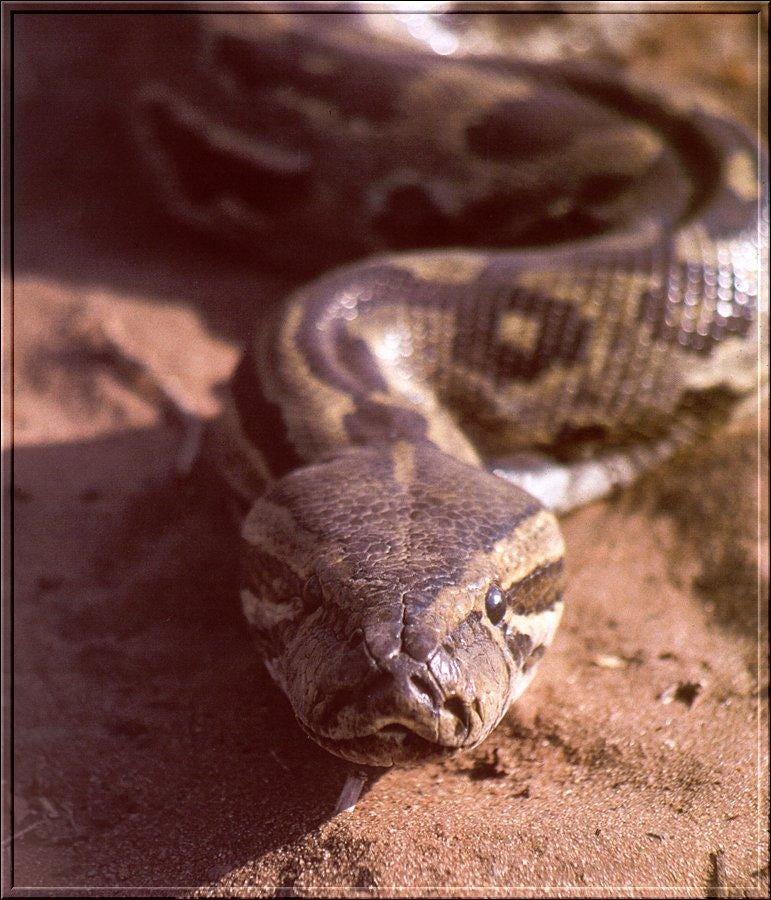From Tribes, Predators and Me, Episode 1. A 17ft Anaconda that was released after its capture for study.
My last article laid a rough foundation for the idea that cognitive modules can be expressed creatively for their unique purposes; or creatively to solve new problems, and be consciously identified, revealing the psychological phenomenon of extended and hyperextended phenotype in humans. It is somewhat of a challenging idea to understand, and I happened to choose a divisive subject to serve as an example. In this article I will outline a much more palatable example, that’s hopefully easier to understand.
People often conceptualize creativity as extending beyond constraint: imagination is thought to be infinite. We teach this to kids, in order to express the idea that striving to accomplish a seemingly impossible goal is much more worthwhile than having a conservative goal that may under-express a kid's ability; or actual possibilities. The boundaries of possibility are not known for many things in life, so when setting a course to achieve a goal, it is useful to think that life and our imagination is limitless, until we obviously reach limits. In having to balance this view, we passively overstate the nature of creativity and imagination, and their usefulness in reaching our goals and forming hypotheses. For example, we may think creativity will resolve a problem when we may actually be at a technical limitation; think about energy production or food production. Those fields are bound by their current technologies and the resources available. But we put off potential problems to the future with the assumption that technology will resolve any issue with innovation; think of soil degradation, pollution, and growing energy demand. It’s a risky bet but we put off these issues to the future; and in some sense rely on creativity to bail us out.
We also do this with regard to humanity and the future of civilization. We allow creativity to fill in the gaps of what we don’t know about the story of human life and consciousness, but we do so blindly and creatively. Since we don’t have the blueprints for how Life occurred, we imagine it. We think about the possibility of Life on other planets, it’s a natural response when we look at the sky. We project our experience onto the cosmos as a conscious attempt to communicate with it, we even do it without language. We do it in our mind, we call out to the sky for a response; we can see this throughout our history. All of our ancestors looked up to the sky, because the sky, like our imagination, seems infinite. It understands that part of us that seeks an understanding, because it is the only other thing that shares this seeming lack of limitation. But this conscious feeling of a lack of limitation may be illusory to some extent, after all we are in a body that will die.
First Deep Field, James Webb Space Telescope
From my experience with creative expressions about Life, like myths, they can be seen as explorations of this biological limitation, driven partially by a form of escapism. This escapist view sees biology as limitation and so we escape from reality into the mind, where consciousness is distilled and absorbs the angst of modern life and transmutes it into creative works that leave an imprint of our motivational drives: like the entire philosophical approach of mind-body dualism. A feature of most of these creative works is the concept of immortality, it’s a logical consequence of being informed about death. When we reach a technical limitation, like death, we use creativity to explore the limitations of the concept; what exactly dies? It’s a legitimate inquiry.
In recent years technology has become highly valued. I noticed that we take these cultural views about the limitations of life and we fight back by creating things. Whether it’s Elon Musk who wants to Occupy Mars; or the public who simply enjoy and demand movies about space; or recent innovations in AI: these endeavors, I believe, come as a result of the exploration and reaction to our limitations. Space and Tech are a creative safe space for people to unpack their existential angst and unresolved conflicts with reality; more so than art is to the Artist. And since we don’t know much about Space or the limitations of Tech, it’s not unreasonable to do this. Like I mentioned at the beginning of this article, it’s best to strive for the impossible or unknown, but under sound philosophical and ethical motivation.
A common synthesis of this sort of ideation about Space is the concept of Aliens. That is what I want to explore here and will get to in a bit. People may not like this, but the New Age fixation with Aliens is the same motivation as the past's cultural fixation with GOD —not to invalidate either. The only difference is in modern times we apply a scientifically informed fascia to the idea, that then legitimizes the phenomenon. Now if it seems that I’ve gone off course, give me a second to get back on track. What do Aliens have to do with creativity; and what does that have to do with extended and hyperextended phenotype? Give me a chance to explain, it was hard to wrangle all this in.
A refresher:
The extended phenotype again, is the manifestation of a phenotype on the world, that manifestation being useful to genes: think of a bird's nest. In order, we have: genes, which are obviously the bird's genes; phenotypes, which are bird’s physical characteristics; extended phenotype, which in this case would be the impact of cognitive modules on the world: a bird's ability to make a nest. Those genes responsible for acting on the world do so by extending themselves for their own interest. This implies that brain structure is purposeful and deterministic —to some extent.
Mattel GAF View Master
Think of a View Master as a metaphor for the concept of the Modularity of Mind. The Human Mind is the contraption itself, and looking through it is Perception. The cognitive modules are each individual slide, which projects unique relevant content that we experience as thought, but that is predetermined by natural selection. Then conceptualize the possibility of connecting each slide together in random variation, as a form of problem solving: what creativity is. Under this view, creativity and imagination are limited, due to biological constraint. It’s obviously a rough idea but I think it’s fitting.
When attempting to apply this rationale about the extended phenotype onto human psychology it may seem impossible, at first thought. We don’t build nests like birds, so how can we observe the extended phenotype in humans, to start discerning ideas? The difficulty is that our brain is not well understood and thought is hidden from sight or conception, so we don’t understand how to conceptualize cognitive modules and their potential to extend or constrain consciousness. But we experience life, and if we’re observant, we can come up with hypotheses based on those first person observations.
One of these cognitive modules in humans is the snake detection module which was discovered by Dr. Lynne A. Isbell, a primatologist and teacher at UC Davis. Snake detection theory is a theory about snakes' impact on primate visual systems. By being capable of detecting snakes quickly, primates were able to evade danger: to survive and reproduce; without the obvious threat of huge and dangerous snakes. This left us with a cognitive module that can detect snakes unconsciously. Snakes quite literally changed the way we see the world. But it also provides insight about how the human brain evolved and its structure. Now let me try to tie this together for the next part: Creativity and imagination are thought to be infinite in popular culture. How can we explain creativity and imagination from an evolutionary perspective; and is it really infinite?
In some of my older writings I wrote about my conclusion that creativity is technically limited. Think of the above View Master metaphor. If each slide is a cognitive module, then the mind is comprised of a limited set of modules, implying constraint. However, creativity can be understood as the random and possibly infinite variation of these modules to solve problems. So we’re technically limited. I experienced this limit of creativity when I tried to conceptualize what Aliens hypothetically look like, strangely enough. I tasked myself with drawing an Alien from “scratch”. The Aliens I drew always had a nose, which assumes Aliens have lungs and breathe oxygen; or some other gas. Two legs, which assumes they’re bipedal, maybe mammals? Arms and fingers, which assumes they may have opposable thumbs, and a mouth which assumes they eat, which assumes they have digestive systems and live somewhere with food available. Each of these traits assumes that Aliens have had a similar, if not identical evolutionary history as humans and life on Earth. This is fine and is probably compatible with the theory of panspermia, but that wouldn’t be an Alien in the popular sense. So with this understanding in mind, I attempted to conceptualize a “real” Alien, an Alien without any human or “Earth specific” biological features. Without anthropomorphic or zoomorphic assumptions, I realized that I could not conceptualize an Alien with my imagination. I can’t imagine Life defined in other ways. It seemed to me that I had reached the limit of the creative expression of living beings in general. For example, an inanimate object cannot see without eyes. Imagine animators, whose job it is to bring objects to life; they are limited by what we perceive as being life-like. The universal symbol for vision is eyes; there is no other way of expressing that an animated object can see, only eyes can imply vision —semiotic anthropology. Life equipped us with a finite characterization of living things, rooted in what we interacted with in our environment evolutionarily.
So, if we can’t conceptualize what we’ve never seen, like Aliens, what do we express creatively when we try to illustrate them? Well, we can describe them by association to things we have seen or experienced. Perhaps our minds do not recognize an image or thing as living without species specific features that we encounter in our environment, and over the course of our evolutionary history. We can creatively distort recognizable physical features to create a distinct alien-like figure, but what is it really? Well, not an Alien. So, when we try to depict Aliens, what do we associate them with in order to describe them and why? If we were to superimpose every person's attempt at an Alien face drawing, what shape and characteristics would that Alien have? I think we can all imagine this Alien face. Take for example the Apple Alien emoji:
Apple Alien emoji
Why does this symbol represent an Alien? Here’s a theory I’ve had since watching X-Files as a kid:
Rough estimates say Ophidiophobia, the fear of snakes, affects a third of the world's population. You can just imagine how prevalent snakes were in our evolutionary history to have made such an impact; and although you might not have a clinical case of Ophidiophobia —if that’s even a thing— everyone is scared of snakes to some degree, because every living thing avoids danger. Dr. Lynne A. Isbell’s snake detection theory posits that this snake detection module is an automatic, unconscious response that precedes subjective experience. So, even before we think, our evolutionarily derived snake detection module reacts to visual stimuli in search of snake-like patterns. So what we perceive is filtered in a sense, it’s an amazing discovery. It implies that our brain is equipped to manage our interactions with the environment, at a level of precision that most people don’t even realize. Her theory focuses on the patterns of snake skin, but I think it’s reasonable to apply her theory to the face of snakes as well.
African rock python. Doesn’t it’s head shape and eyes look Alien-like?
What if it’s the case that this snake detection module projects itself onto creative expressions of what we fear, such as Aliens; doing so in the manner I described above, in the View Master metaphor? What do snakes and the concept of Aliens have in common that would trigger this hypothetical response? Well it’s simple and really not scientific: popular culture characterizes Aliens in ways that would induce fear, which could trigger the unconsciously operating snake detection module; it is a biological attempt to predict what to fear, and what to look out for! There are countless movies that depict Aliens and our hypothetical response to them. Our depictions of Aliens look a lot like snakes to me.
So in this scenario, we see the extended phenotype of the snake detection module, as a psychological concept, expressed artistically and unconsciously as hyperextended phenotype. It being hyperextended phenotype, an elaboration of Dawkins “meme” because it doesn’t serve its “intended” purpose.
Now since it is the case that a snake could make its way into our literal biology, being that it was so present in our evolutionary history, is remarkable. That is to say, a physical object can be of such relevance or importance to the survival of genes that it is modeled in our own mind, it’s an incredible discovery. This phenomenon begs another question, relevant to the extended phenotype: what other stimuli or animals were equally present and dangerous in our environment, and are they represented in our minds like snakes are? Well, how about our relation to other people? This leads to my hypothesis about the Bible being a creative projection of our innate ethical system, which is composed of cognitive modules that deal with the environment in the same manner as the snake detection module, in order to derive action.
To close this inquiry out, I want to point out something funny, if my far out hypothesis is somehow true about Aliens: If it’s true that our conception of Aliens is distorted by our own mind, it would imply that we don’t know what Aliens look like obviously. So every person who has ever claimed to have been abducted by Aliens, or has said they have seen Aliens; and if those Aliens are depicted like the ones I described: maybe they are lying! Haha.
I do not think Aliens are real, personally. I think we are the most special Living things on the planet and in the Universe. But, like Mulder from The X-Files said: I want to believe! Thanks for reading.








